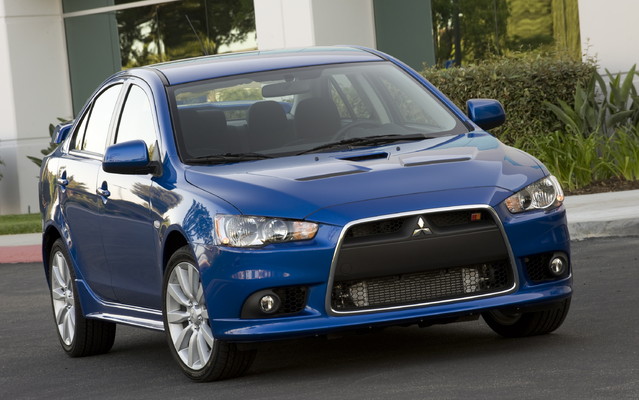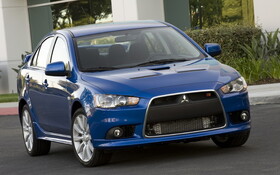A More Natural Evolution Isn't: The 2009 Mitsubishi Lancer Ralliart

| Strong points |
|
|---|---|
| Weak points |
|
A few years ago, I had a very interesting conversation with a Mitsubishi executive that shall remain unnamed. Eager to discuss Mitsubishi’s upcoming plans for the then-secretive Evolution X, the mystery executive divulged two very intriguing things; first, that the Evo X would be coming to Canada, and second, that Mitsubishi would be releasing an all-wheel drive, turbocharged high performance version of the Lancer that would fill the substantial price gap between the standard model and the upcoming Evolution.
This is that car. Entitled the Mitsubishi Lancer Ralliart, it enters the market directly opposite the long loved WRX. Doing away with the expensive Evolution unibody, the Ralliart starts life as a standard, run-of-the-mill GTS. But, while the standard GTS makes do with some pretty pedestrian componentry that’s more aimed towards practicality than enjoyment, the Ralliart heaps the proverbial platter with a smorgasbord of performance infused goodies. But, while Subaru’s WRX has slowly been earning one hell of a reputation in its numerous years of service in this country, does the Ralliart have the cajones to lend some credibility to the relatively unknown Ralliart name?
Well, given the first step towards a Ralliart’s completion involves the implementation of a slightly detuned version of the Evolution’s turbocharged 4B11T 2.0L four cylinder, I’d say things are probably looking up at Ralliart’s headquarters. Although lacking 54 of the Evolution’s horsepower (mostly due to the use of a smaller single scroll turbocharger versus the Evolution’s double scroll behemoth), the Ralliart still packs a 237 horsepower punch, but it’s far from slow. Weighing over a hundred pounds less in similar guise, the Ralliart still hustles down the road with vicious alacrity, the smaller turbocharger giving more brutal throttle response in exchange for the Evolution’s mind-bending top end rush. In other words, it almost feels more willing to point and squirt down the road at slightly more reasonable speeds than the Evolution’s long legs enjoy. Proof of that fact can be found in the torque curve, which sees the peak (253 lb-ft) torque production hit its peak at just 3,000 rpm, a significant drop from the Evolution’s 4,000 rpm mark. Granted, the Evolution may make as much torque at 3,000 rpm as the Ralliart, but the way it builds is altogether different, with the Ralliart feeling much more linear than the Evolution’s exponential acceleration.
Of course, that smoother torque application also helps make the auto-manu-matic flappy paddle gearbox far more liveable as well. First encountered in the Evolution MR, this gearbox has not made any fast friends in my circle of friends, as it seems to take forever to engage, makes daily driving a chore, and seems to hate doing the one thing a gearbox should do: shift gears. Oh sure, throw it in Super Sport mode (a mode that appears to be Evolution specific as no amount of button mashing, pushing, or holding could convince the LEDs in the dashboard to arrange themselves in the form of the “S.Sport” indicator) and shifting yourself cracks off flawless shifts at a pace that recalls the inner workings of a fully automatic weapon, but the problem is that the shifts are about as relaxing as an automatic weapon as well. In the Ralliart, the lower power output and more linear acceleration means the transmission reacts in a much smoother way. Left to its own devices, the SST transmission is predictable and willing, and its overall operation is much less noticeable. In traffic, you still notice some lag as the computer controlled clutches take up the weight of the car, and there is the occasional jolt when the transmission is forced to react quickly to sudden deceleration, but it’s a huge improvement over the sadistic behaviour of the Evo MR’s. And that’s a good thing too, since you have no other option in the Ralliart. Without a traditional manual transmission on the options list, Mitsubishi’s taking a pretty big gamble on the success of the SST transmission, although after my experiences, I can honestly say that it’s the one I’d want anyway.
Aft of that high tech transmission is the first of the Ralliart’s big deviations from its WRC-bred stablemate. While the Evo enjoys forged aluminum control arms and a fancy active rear differential, the Ralliart borrows the All-Wheel Control system of the 2005-2007 Evolution IX and pairs it with traditional mechanical limited slip diffs front and rear. This means that you forgo the Evolution’s torque biasing ability, which to be honest, 99% of buyers will never utilize nor appreciate. But while we may do without the fancy rear diff, the use of the All-Wheel Control system means that owners can still select the front to rear torque bias through a computer controlled clutch pack in the centre diff. As with the Evo, that means the driver can select either tarmac, gravel, or snow on the dashboard display to shuttle more torque to the front wheels; an infinitely more useful feature for us buyers trapped in the Great White North.
And, having just spent a very hot, very dry week aboard a Lancer Ralliart, I can honestly say that most owners should be praying for snow, because on dry pavement, this thing’s an understeering pig the likes of which I haven’t seen since my Power Wheel days. Of course, that might be because the completely overwhelmed Yokohama 215/45R18 tires are about as useful as hard plastic faux-tires when it comes to changing direction. Yup, they’re as good at holding their ground as the French, and are as intelligent an idea as the Maginot Line. When forced to deviate from their preferred direction, they appear to attempt to increase their contact patch by throwing as much of the sidewall as possible under the front wheels to the point that my tester’s shoulder blocks had been blended seamlessly into the sidewalls, and the top half of the “Yokohama” script had obviously been ejected onto Vancouver’s city streets. This has a horrendous effect on handling, and completely neuters the excellent chassis’ ability to stretch its legs. Recording underwhelmed skidpad figures at other publications, the best way to correct this problem is one of the following: A) moving to an ice shelf, or B) start a rigorous right arm workout program in preparation for the abuse you’re about to unleash on that unsuspecting e-brake handle. Oh, or get new tires. And while you’re at it, you may want to invest in some new wheels too, since the stock GTS wheels that come on the Ralliart look downright out of place, especially in a marketplace that’s dominated by models that use specific wheels to delineate their high performance models from the rest of the lineup (reference: Subaru WRX, Mazdaspeed3, Caliber SRT4, Cobalt SS, etc etc). At a less spirited pace, the Ralliart is definitely more Evolution than Lancer. It tingles like the Evo, sounds fantastic, and has the same quick, responsive handling as the Evolution... just turned down from 11 to maybe 8 or 9.
So, to return to the original question, the answer is yes. It definitely does have the cajones to give the Ralliart brand a whole whackload of credibility. Sure, your first encounter with the monster known simply as understeer will traumatize you, and you may need to consider the cost of subsequent therapy in the financial decision... but thankfully the fix is as close as your local tire shop. And since the Ralliart clocks in at just $32,998, there’s plenty left in the bank to buy a pretty decent wheel and tire package. Of course, that puts it frighteningly close to the Evo’s $39,998 admission fee. But, with all the right basic building blocks, it puts $7,000 back in your pocket and gives you chance to own something significantly more mature than the Evo. And should you ever feel the need for more speed, that $7,000 you saved can buy you a whole lot of horsepower.











